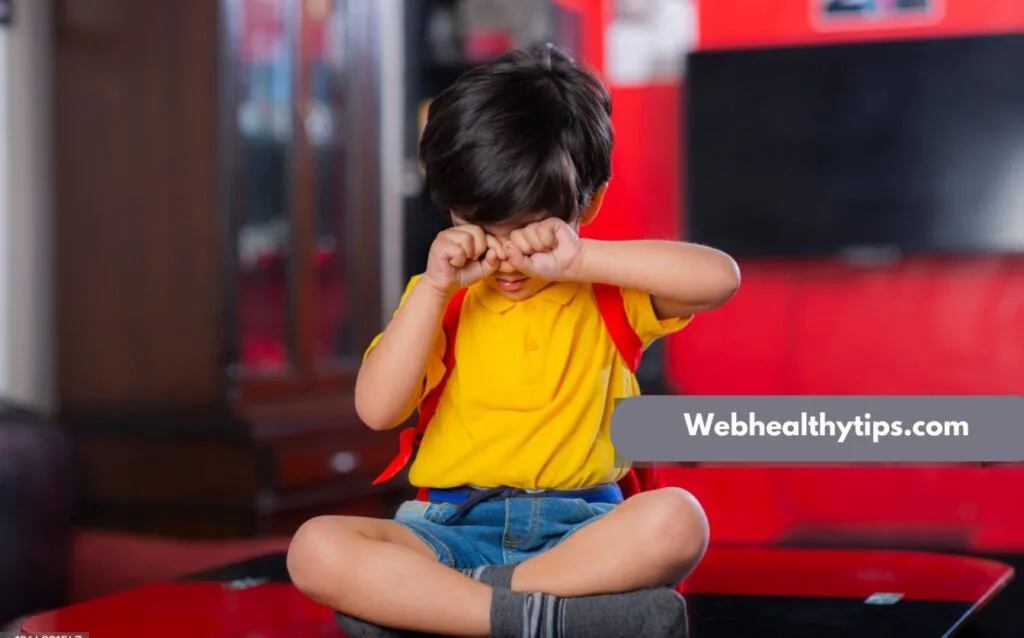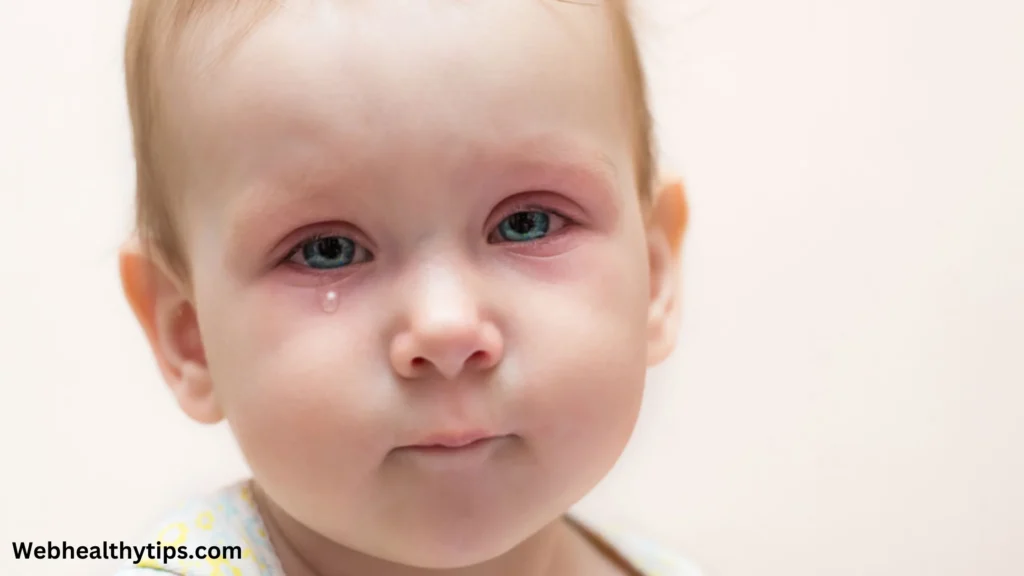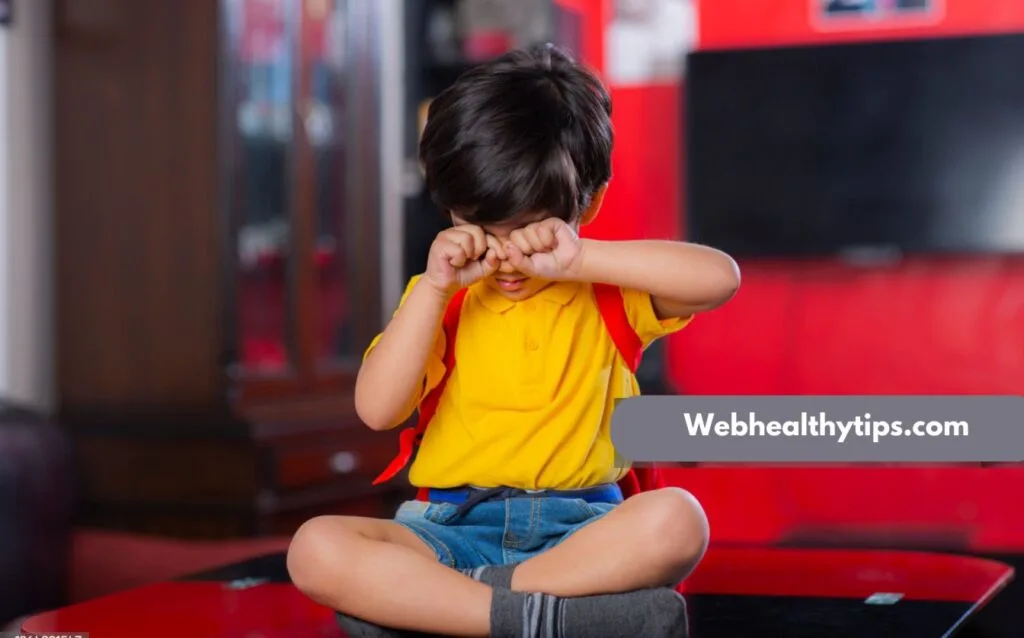
Babies’ sensitive appearance often results in parents seeing tiny changes in their appearance that could worry them. Redness beneath the eyes is a common issue that may cause concern for caretakers. Babies’ red under-eye circles can be caused by a number of things, but allergies are one of the most common ones. This post will discuss the relationship between red under the eyes and baby allergies, as well as typical causes and treatments for the condition.
Identifying Red Under Eyes in Babies
There are several reasons why a baby’s undereye circles could turn red, but most often it’s allergies, fatigue, or discomfort. When allergies are present, redness in the eyes is frequently accompanied by additional symptoms such sneezing, watery eyes, and irritation. Due to the high sensitivity of the skin surrounding an infant’s eyes, even small irritants might result in visible reactions.
Common Reasons for Babies’ Red Under Eyes

a. Exhaustion
A major cause of red circles around the eyes in neonates is fatigue. Under their eyes, babies who don’t get enough sleep may grow red or black circles. Make sure your infant is sleeping the number of hours that correspond to their age.
b. The absence of water
Dehydration can lead to pale skin and more visible blood vessels around the eyes, which can make under-eye circles appear red or black. Make sure your infant is getting enough water on a daily basis.
c. Sensitivities
One of the most frequent reasons why babies become red under their eyes is allergies. Histamines are released by the immune system in response to allergen exposure in babies, and this can result in ocular edema, redness, and itching.
Babies’ Allergic Reactions
When the immune system overreacts to innocuous items like dust, pollen, or specific foods, allergic reactions occur. This reaction in infants can result in a number of symptoms, such as rashes, congestion in the nose, and red eyes.
Signs of Allergies in Infants
If allergies are the cause of your baby’s redness under the eyes, you may also notice the following symptoms:
- Watery, itchy eyes: Allergy-prone babies frequently massage their eyes because they are uncomfortable.
- Allergens have the ability to irritate the nasal passages, resulting in runny noses and sneezing.
- Eczema or rashes: Skin irritations such as eczema can also be signs of allergic reactions.
- Coughing or wheezing: If an allergen irritates a baby’s airways, they may occasionally exhibit respiratory symptoms.
Typical Allergens Impacting Infants

Parents can determine the source of their baby’s allergy by being aware of the variety of allergens to which their child may be susceptible.
a. Dust mites
Microscopic creatures called dust mites reside in carpets, soft furnishings, and mattresses. They may frequently cause allergic responses in infants, which result in redness under the eyes.
b. Pollen: Babies may experience symptoms from pollen-related seasonal allergies, also known as hay fever, particularly in the spring and summer when pollen counts are high.
c. Animal Dander
Sensitive babies may experience allergies due to pet dander, which is microscopic skin particles. Redness and itching around the eyes are common results of this.
d. Hypersensitivity Reactions
Some infants’ immune systems react because of dietary sensitivities. Soy, nuts, eggs, and milk are common allergies. Food allergies can cause hives, rashes, and itching around the eyes.
How to Identify Allergies in Infants
A precise diagnosis is necessary to rule out allergies as the cause of your baby’s red undereye circles. The following actions can be helpful:
- Keep an eye on your symptoms
Observe your baby’s symptoms closely. Make a note of the redness’s onset time and any additional symptoms, such rashes, watery eyes, or sneezing. - Testing for Allergies
Speak with a pediatrician; they might suggest allergy testing. The allergens causing your baby’s allergies can be identified with the use of blood or skin prick testing. - Dietary Elimination
Your pediatrician may recommend an elimination diet if food allergies are suspected, which involves removing specific foods from your baby’s diet in order to identify the allergen.
The Best Treatments for Infant Allergic Red Under Eyes
Parents might attempt a few different methods to treat their baby’s allergy-related red under eyes. The following are some of the best methods for easing your baby’s discomfort:

a. Cool Compress
Reducing swelling and relieving irritated skin can be achieved by applying a cool compress to the affected region. All you have to do is refrigerate a moist cloth for a few minutes, then gently dab it into your baby’s eyes.
b. Maintain the Environment tidy
Some common allergens that might cause redness under your baby’s eyes are dust mites, pet dander, and pollen. To reduce exposure, vacuum your carpets, wash your baby’s bedding, and clean your house on a regular basis.
b. Make Use of Hypoallergenic Items
Make the switch to hypoallergenic cleaning and skincare products to spare your baby’s skin irritations. Strong chemicals and fragrances might intensify allergic symptoms.
d. Apply moisture
If dry, flaky skin is present along with the redness, using a light, hypoallergenic moisturizer can help reduce irritation.
e. Supplemental antihistamines
To lessen allergy symptoms, your pediatrician can occasionally suggest an antihistamine that is safe for infants. Before giving your child any medication, always get a medical consultation.
f. Humidifier
By keeping the air in your baby’s room humidified, you can lessen the effects of allergies like dust mites.
Keeping Infants Free from Allergies
Reducing your baby’s exposure to allergens is essential to preventing allergies. The following advice can help lower the possibility of allergic reactions:
- Nursing
Breastfeeding has been demonstrated to strengthen a baby’s immune system, lowering the likelihood of allergies. For the first six months of your baby’s life, breastfeed only. - Manage Dust Mites
Use dust-proof covers on pillows and mattresses and wash your baby’s bedding in hot water once a week to reduce the number of dust mites in your home. Steer clear of plush animals and thick draperies as they may contain dust mites. - Minimize Contact with Pets
If your child is allergic to pet dander, you may want to consider removing pets from their room and giving them frequent baths to help prevent the accumulation of dander. - Provide Firm Foods Gradually
Finding any food sensitivities might be aided by progressively introducing solid foods. Prior to adding additional ingredients, start with meals that just have one ingredient and wait a few days.
When to Consult a Physician

Even though modest redness under the eyes is frequently treatable at home, sometimes medical attention is required. See your child’s physician if:
- The redness lasts for several days or longer.
- Your infant appears to be having trouble swallowing or breathing.
- Severe allergic reactions might cause facial or lip edema.
- Over-the-counter medications don’t work.
In summary
Allergies are among the most frequent causes of redness behind a baby’s eyes, although there are other possibilities as well. Parents can help ease their baby’s distress and avoid more allergic reactions by being aware of the triggers and symptoms. Treating allergies in infants can result in healthier, happier lives, whether by environmental controls, calming treatments, or doctor consultation. It is always advised to seek professional medical assistance if symptoms intensify or persist.

